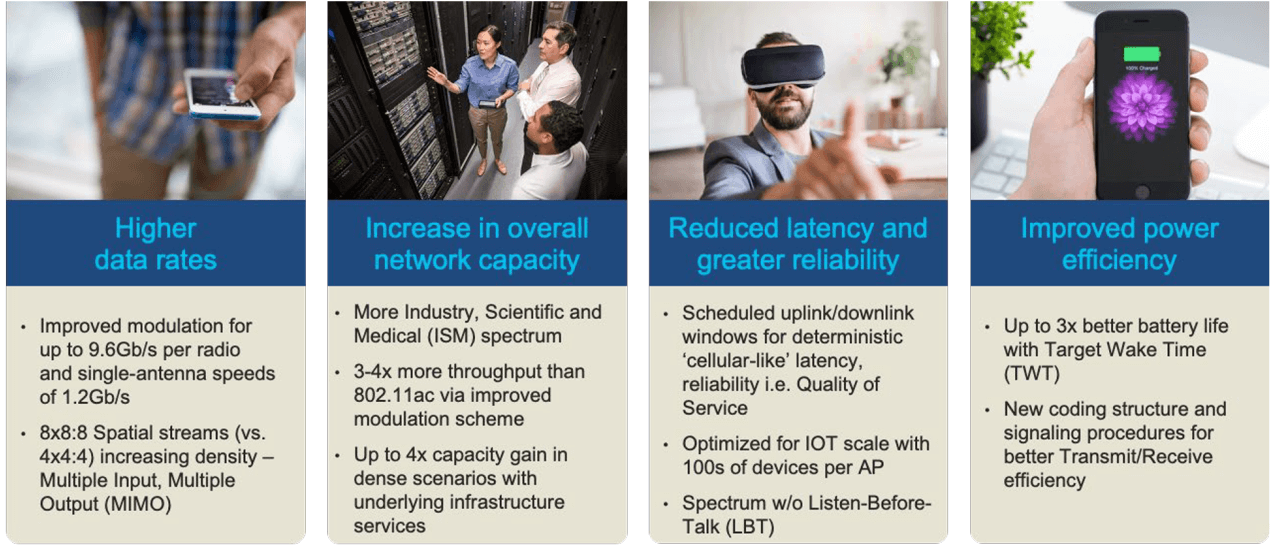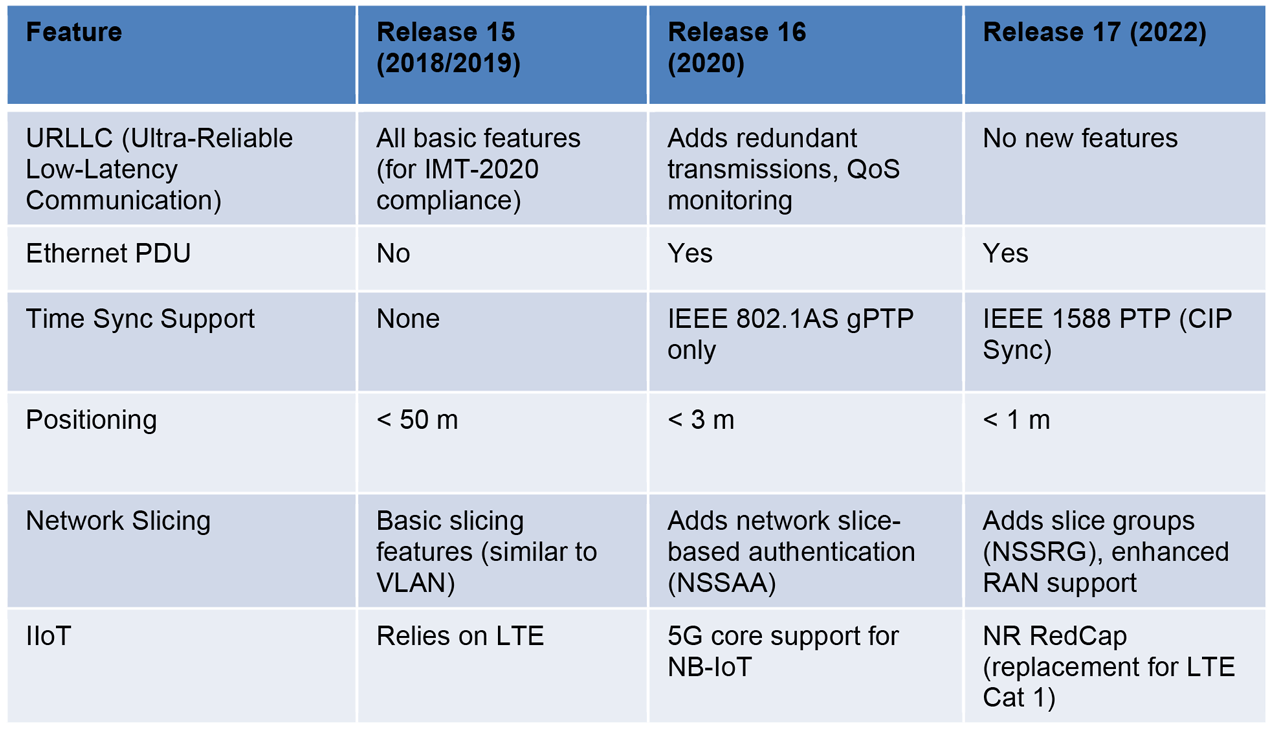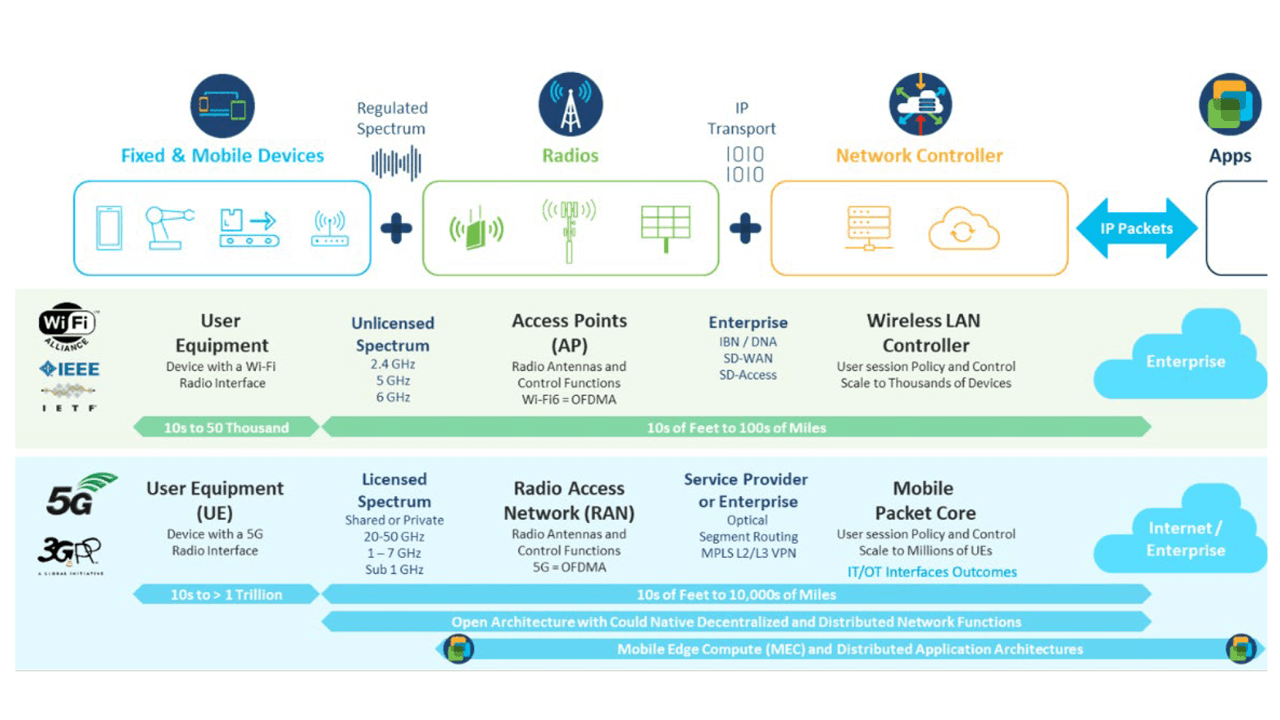TechnologyNovember 18, 2023
Industrial automation wireless networks update

Wireless technology choices are growing led by Wi-Fi, 5G/Private 5G, sensor networks, Bluetooth, ultra-wideband and other reliable wireless technologies. These technologies offer enhancements for industrial use cases and also present new opportunities to enhance safety, security and efficiency in factory environments.
Industrial Wireless is no longer just an extension of the Enterprise Wi-Fi. Industrial wireless use cases are increasing in industrial operations: AR/VR assistance for personnel, location services, high speed SW downloads to products and mobile machinery and assets.
The wireless technology choices are also growing: Wi-Fi, 5G/Private 5G, sensor networks, Bluetooth, ultra-wideband and other reliable wireless technologies. The technologies are making enhancements for industrial use cases. All offer opportunities to enhance safety, security, and efficiency.
This article will explore the wireless options providing key considerations around Use Case, Spectrum, Distance, Reliability, Speed, Latency, Management and Total Cost of Ownership. Additionally, we will consider how ODVA may be able to help users and vendors integrate wireless technologies for use in CIP communications.
Use cases
Industrial wireless technologies are ever improving and evermore utilized in industrial operations. The technology improvements are meeting more and more of the industrial requirements, including:
- High-bandwidth and throughput to bandwidth intensive applications such as video streaming, augmented/virtual reality and tele-remote support
- Low latency to support tighter industrial automation and control applications, including CIP Safety
- High-availability via improved interference avoidance, faster roaming and lower packet-loss rates
Key use cases where industrial wireless play key roles include:
- Smart devices: smart phones and tablets
- Automated Guided Vehicles: autonomous robots and vehicles moving product and parts around production facilities
- Surveillance Cameras: streaming video for surveillance and vision control
- Human Machine Interface: mobile HMIs keep operational personnel connected
- Remote Expert: integrated remote engineers and support for deployment and problem resolution
- Augmented Reality/Virtual Reality: mobile AR/VR headsets to improve personnel effectiveness
- Sensors, Actuators: wireless sensors and actuators where wired connectivity is challenging
- Wireless Tooling: More effectiveness and efficient tooling when not tethered
- Mobile Work-Cell: flexible, nomadic production equipment and assets
- Product Downloads: download Software and data to intelligent products.
Wi-Fi current state
Currently, the most recent available Wi-Fi technology is based on Wi-Fi 6/6E technology. Wi-Fi 6 technology (IEEE 802.11ax) is currently shipping where much of the infrastructure is ready to support the additional spectrum allocation referred to as Wi-Fi 6E.
As of the writing of this article, Wi-Fi 6E is available in a number of countries, including the US, although only a limited set of devices support it yet. Specifically, low-power indoor (LPI) devices support 6E. Most industrial Wi-Fi 6 devices must disable support for 6E because they do not have integral antennas and/or have enclosures that could be used outdoors (even if they are intended to be used indoors, but must withstand washdown).

Figure 1 – Wi-Fi 6/6E enhancements

Figure 2 – Wi-Fi 6/6E available spectrum diagram.
Wi-Fi 6/6E update
The following summarizes key enhancements in Wi-Fi 6/6E. In addition to these features, Wi-Fi 6E grants additional access to 1200 MHz of relatively clean spectrum in the newly-opened unlicensed 6 GHz band that significantly increases the available spectrum (roughly @200% increase in the US, @100% increase in EU), improving data rates, lowering interference and supporting more applications.

Figure 3 – Enhancements expected in Wi-Fi 7.
Wi-Fi 7 update
As of the writing of this article, the Wi-Fi Alliance is working on Wi-Fi 7 and is expected to be ratified in 2024. The IEEE IEEE is still working on IEEE 802.11be.
Wi-Fi 7 continues the improvements in resiliency, bandwidth and denser deployments of devices. Wi-Fi 7 currently includes enhancements for industrial applications around resiliency and priority.

5G feature releases
5G update
3GPP is the organization that creates 5G standards. The standards cover the complete 5G architecture – UE (User Equipment) end-devices, RAN (Radio-Access Network) and Mobile Packet Core. The standards are delivered in releases. Here are some considerations about 3GPP standards:
- Feature release for telecom providers remains 5G vendor priority
- There is significant lag between 3GPP specification release and commercial availability (particularly of “industrial” features not needed by telecom): Release 16 completed in 2020; no infrastructure supporting Release 16 features (e.g., time sync support) until end of 2023 / early 2024
- 5G modems more closely follow 3GPP releases: some updates are via firmware, but many require new silicon; more likely to see 5G modems advertised as “Release 16-compliant”
- Infrastructure adds features from future 3GPP releases incrementally: typically via software update; follows vendor internal roadmaps; features from lower-numbered 3GPP releases are generally added first; and some features (e.g., localization) may require special hardware support in basebands
- Even though the standards are released groups, UE, RAN and MPC vendors can pick and choose what features and functions to deliver.
5G and CIP

Figure 5 – 3GPP PTP support as of Release 17
The good news is that 5G natively carries EtherNet/IP traffic, as it is based on TCP/IP. A few other notes about 5G and industrial networks:
- Support for Ethernet frames was added in 3GPP Release 16, specifically Ethernet protocol data unit (PDU) sessions: most existing 5G equipment on the market today does not support Ethernet PDU
- EtherNet/IP is carried by TCP and UDP, so EtherNet/IP can run on any 5G: most industrial protocols need special tunneling (e.g., VXLAN) or Ethernet PDU support
- Special support is needed for: Time synchronization (motion); Multiple devices behind a UE
- 5G typically requires UEs to request a schedule to send data uplink which may disrupt low-latency communications, which can be mitigated via Grant-Free Scheduling
- Along these lines, typical 5G systems are configured to prioritize downlink data (e.g., video streaming) over uplink, whereas industrial communication creates nearly symmetric uplink and downlink traffic. This can be mitigated with 1:1 slot ratios.

Figure 6 – Industrial Use Case – multiple devices behind a UE connection.
5G and Precision Time Protocol
5G base stations must be synchronized to a GPS-derived clock to avoid interference with neighboring cells. GPS time is distributed to UEs via a system information block (SIB), specifically SIB 9 for standalone networks and SIB 16 for non-standalone networks that rely on LTE. The distribution of GPS clock data, combined with a method such as timing advance (TA) to correct for signal time of flight, allows all elements of the 5G system to remain synchronized.
3GPP has added features to support industrial PTP protocols (IEEE 802.1AS gPTP in Release 16 and standard PTP / CIP Sync in Release 17).
While details may be vendor-specific, the basic mechanism to support PTP works as follows:
- A 5G system (5GS) supporting Release 16+ will correct residence time via TSN Translators (TTs)
- There are two types of TTs: device-side TT (DS-TT; TSN master), and network-side TT (NW-TT)
- Ingress traffic into the 5G system is timestamped; on egress, the TTs subtract the current time from the ingress timestamp to compute residence time, which is added to a correction field
- In essence, the 5G system acts like a single switch implementing a PTP transparent clock
- The PTP Grandmaster may be internal or external to the 5G system; at most one NW-TT can be a TSN slave
Support for multiple devices behind single UE
Cellular was originally designed for phone and eventually smart phone use, where all traffic was to/from a single end device. As such, it is still developing “bridging” functions similar to Work-Group Bridges found in Wi-Fi networks.
A few points about support for multiple devices behind a single 5G user equipment (UE):
- It is advantageous if a single UE can support multiple automation devices: 5G UEs (modules or routers) are expensive; many automation devices are located in metal cabinets that block RF, so it often doesn’t make sense to integrate 5G radios in these devices
- Tunneling / VXLAN can be used to support multiple devices behind a single UE: mMay need an “extra box” behind UE to act as a tunnel endpoint; and some UEs have tunneling support or can run containers (e.g., with OpenVPN)
- 5G also supports “framed routing” (3GPP TS 23.501 §5.6.14): originally developed as part of RADIUS (RFC 2865); 5G vendors may call this feature “Routing Behind Mobile Station” or “Routing Behind UE”, but it is typically implemented using framed routing
- Example of how framed routing works: allocate small subnet (/27 or smaller) behind UE; this subnet is associated with a user name and password, stored in the 5G core; when a 5G UE initially connects (attaches) to a network, it authenticates using SIM credentials (primary authentication); a 5G UE may also authenticate to a specific data network using EAP (typically via PAP or CHAP) with a user name and password; this is called secondary authentication; and when the UE performs secondary authentication, a route is created in the core to the subnet associated with the secondary authentication credentials.
Grant-free scheduling

5G NR Scheduling Procedure
5G UEs typically must request permission (a grant) to send uplink data. This adds delay and increases inter-packet delay variation (colloquially called jitter), both of which are problematic for CIP protocols. The added delay from this scheduling procedure also generally precludes very low-latency applications.
Grant-free scheduling (also called transmission without grant, TWG) avoids the added delay and packet delay variation caused by uplink scheduling. It works as follows:
- The 5G base station reserves resources for uplink for each UE; the UE can transmit on these reserved uplink resources at any time
- The periodicity of the grant-free uplink resources is adjustable; ideally this period would be the same as the CIP packet interval, but synchronization may not be possible
- In general, grant-free schedule reduces latency at the expense of throughput since reserved uplink resources may not be used
1:1 slot ratios

Figure 7 – Wi-Fi and 5G architectures.
EtherNet/IP typically has approximately equal traffic in each direction. Typical cellular use cases are downlink heavy (e.g., streaming video). In fact, most 5G equipment initially only supported a few fixed downlink to uplink ratios with at best a 4:1 downlink to uplink ratio.
This downlink uplink asymmetry creates several problems for EtherNet/IP traffic. First, it creates a bottleneck in the uplink direction, which may cause extra queuing delay for CIP connections in this direction. A second, less-obvious effect is that it also increases the time required for physical-layer retries when the uplink slots are fewer and farther apart. This adds delay and increases inter-packet delay variation.
Therefore, usage of slot ratios as close to 1:1 as possible is advantageous for EtherNet/IP traffic. A few points about 1:1 slot ratios:
- 5G divides resources in time into frames, subframes, slots, then symbols; Individual symbols can be allocated for downlink, uplink, or flexible
- With time-division duplexing, slots (each containing 14 symbols) are typically allocated as downlink (D), uplink (U), or special (S; mix of symbols)
- It takes time to switch radios between transmitting and receiving, so blocks of downlink or uplinks slots allows higher throughput
- Slot patterns sets ratio of uplink to downlink traffic, as well as retry delay
- 5G base stations and UEs initially offered only a few fixed slot ratios
- Closest to symmetric was 4:1 downlink to uplink, such as DDDSUUDDDD
- Current 5G equipment may offer nearly 1:1 slot ratio, e.g., DDSUU
- Even with an exactly 1:1 slot ratio, downlink throughput is typically better due to MCS differences, such as higher-order QAM in downlink
Key industrial considerations
The key considerations when choosing wireless communications include:
- What are the devices to connect? Cranes, AGVs, tablets, sensors etc.
- What are the applications requirements? Latency, reliability, nomadic/stationary, etc.
- What are the deployment Scenarios? Regional regulations, spectrum, indoor/outdoor, access/backhaul
- What are the potential technology options? Wired: Ethernet, serial, DSL; Wireless: Wi-Fi and Ultra-Reliable Wireless Backhaul, 5G Cellular, Wi-SUN, LoRaWAN; and Spectrum: Unlicensed, Licensed: Private, Public, Shared
- CapEx and OpEx Implications?
ODVA Impact
As stated above, CIP and EIP are already well suited for both Wi-Fi and 5G communications with a few noted caveats, especially around time synchronization and motion applications. Both technologies are designing improvements for industrial control applications.
David Brandt, Principal Engineer, Rockwell Automation; Paul Didier, Solution Architect, Cisco; and Bob Voss, Distinguished Engineer, Panduit


